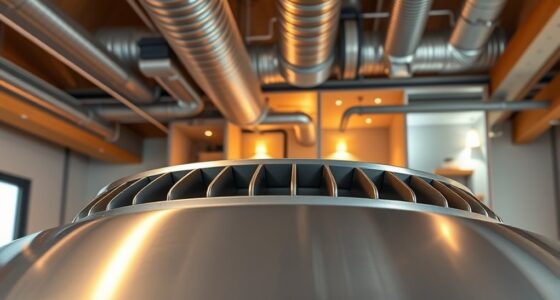The number of air changes per hour (ACH) you need relies on your space’s purpose and size. Typically, residential rooms require around 0.5 to 1 ACH, while commercial spaces need 4 to 6 ACH, and healthcare facilities often aim for 10 to 15 ACH for infection control. Proper ACH ensures good indoor air quality, comfort, and energy efficiency. If you want to find out the ideal ACH for your environment, keep exploring the details below.
Key Takeaways
- ACH requirements vary by space type: 0.5-1 for residential, 4-6 for offices, 10-15 for healthcare.
- Proper ACH balances air quality with energy efficiency, preventing stale air and excess energy use.
- Calculate ACH by dividing room volume by desired air change time, then multiply by 60 for hourly rate.
- Regular monitoring with CO₂ sensors and airflow measurements ensures ACH stays within recommended levels.
- Achieving the right ACH improves indoor air quality, reduces pollutants, and maintains a healthy environment.
What Is Air Changes per Hour (ACH)?
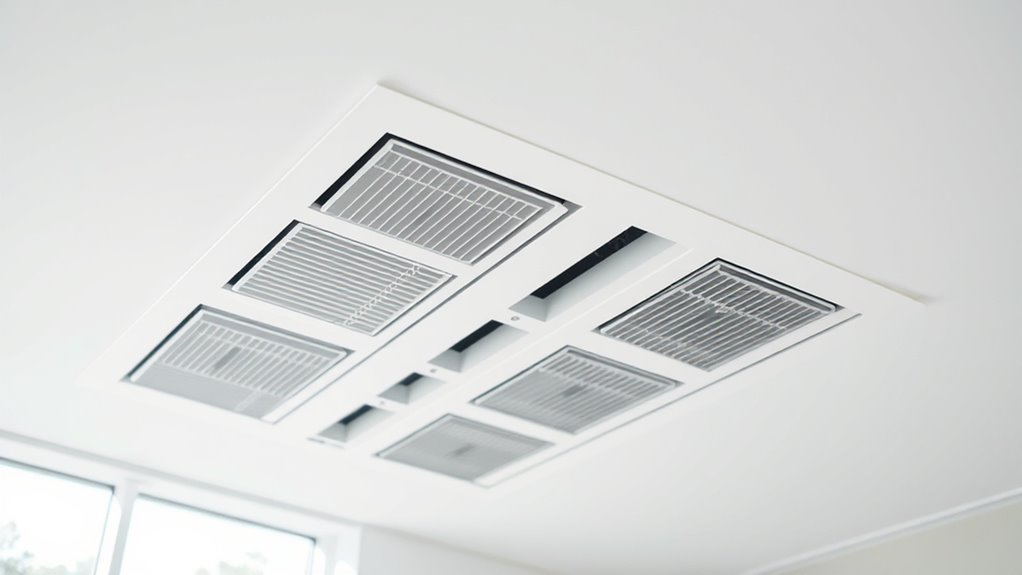
Air Changes per Hour (ACH) measures how many times the air within a space is replaced or exchanged in one hour. It’s a key metric used in ventilation standards to guarantee indoor air quality. Higher ACH values mean better air circulation, reducing airborne contaminants and odors. To determine appropriate ACH levels, building codes and health guidelines specify minimum air exchange rates based on space use and occupancy. For example, offices might require lower rates than hospitals or laboratories. Understanding ACH helps you assess if your ventilation system is effective. It’s essential for maintaining a healthy indoor environment, especially in enclosed spaces where air can become stagnant. By monitoring ACH, you ensure your ventilation standards align with recommended air exchange rates for comfort and safety. Proper ventilation is vital for indoor air quality and occupant health.
Why ACH Matters for Indoor Air Quality
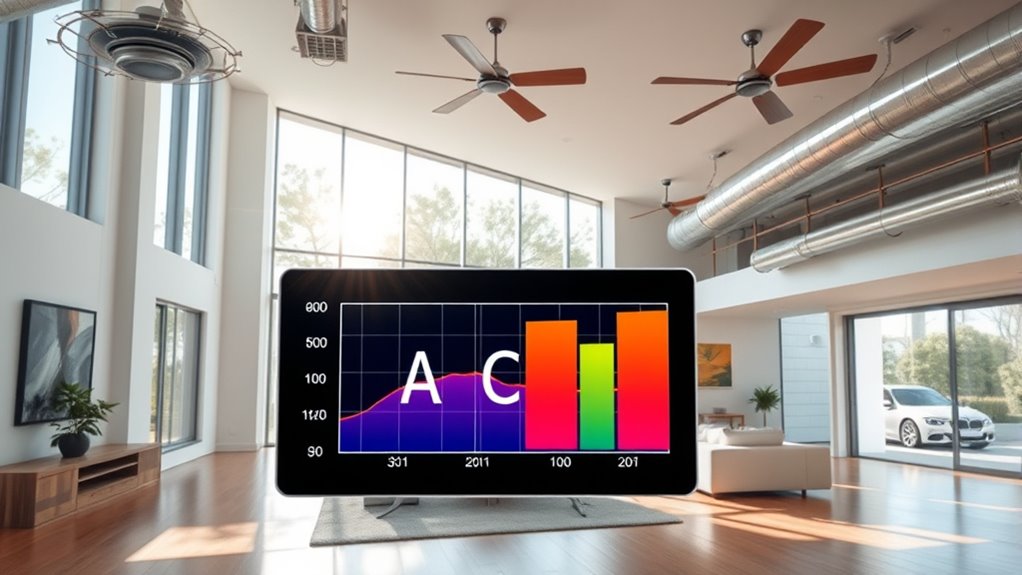
Understanding why ACH matters helps you see how ventilation directly affects indoor air quality. When airflow is right, it reduces pollutants and keeps your environment healthier. Proper ACH is essential for protecting your indoor spaces and your well-being. Additionally, selecting the right air purification technology can enhance the effectiveness of your ventilation strategy.
Impact on Air Quality
Maintaining proper air changes per hour (ACH) is essential because it directly influences indoor air quality. When airflow is sufficient, pollutants like dust, allergens, and VOCs are effectively removed, creating a healthier environment. Proper ventilation design ensures that stale air is replaced with fresh air, reducing indoor contaminants. Air filtration systems work best when paired with appropriate ACH rates, trapping particles before they circulate. Insufficient ACH can lead to poor air quality, causing discomfort and potential health issues. Conversely, too high ACH might cause drafts and energy waste. Striking the right balance improves air clarity and overall comfort. By optimizing ACH, you support cleaner indoor air, benefiting everyone who spends time inside your space. Additionally, understanding the importance of proper ventilation can further enhance indoor air quality outcomes.
Protecting Indoor Health
Since proper ACH levels directly impact the quality of indoor air, guaranteeing the right amount of ventilation is essential for protecting your health. Meeting ventilation standards helps reduce indoor pollutants, allergens, and pathogens that can cause health issues. Adequate air changes improve air filtration, removing airborne particles and contaminants effectively. Without proper ACH, pollutants can accumulate, increasing the risk of respiratory problems and illnesses. You should evaluate your space’s ventilation standards to determine the ideal ACH, especially in high-traffic or enclosed areas. Incorporating effective air filtration systems further enhances indoor air quality by capturing microscopic pollutants. Properly designed Self Watering Plant Pots can contribute to healthier indoor environments by maintaining optimal humidity levels. Maintaining the right ACH ensures fresh, healthy air circulation, safeguarding your well-being and creating a safer indoor environment.
Typical ACH Recommendations for Different Spaces

Different spaces require specific ACH levels to guarantee good air quality and reduce the spread of contaminants. Ventilation standards recommend varying ACH rates based on the room’s purpose and occupancy. For example:
Different spaces need specific ACH levels to ensure air quality and reduce contaminants.
- Residential rooms typically need 0.5 to 1 ACH for adequate air purification and comfort.
- Offices and commercial spaces often aim for 4 to 6 ACH to maintain healthy indoor air quality.
- Healthcare settings, such as hospitals, require higher ACH, around 10 to 15, to ensure effective air exchange and infection control.
These recommendations help minimize airborne contaminants and support proper ventilation standards. Knowing the right ACH for your space ensures you’re providing a safe environment, reducing the risk of airborne disease transmission, and maintaining ideal indoor air quality. Understanding ventilation standards plays a crucial role in designing effective air exchange systems.
How to Calculate the ACH Needed for Your Room
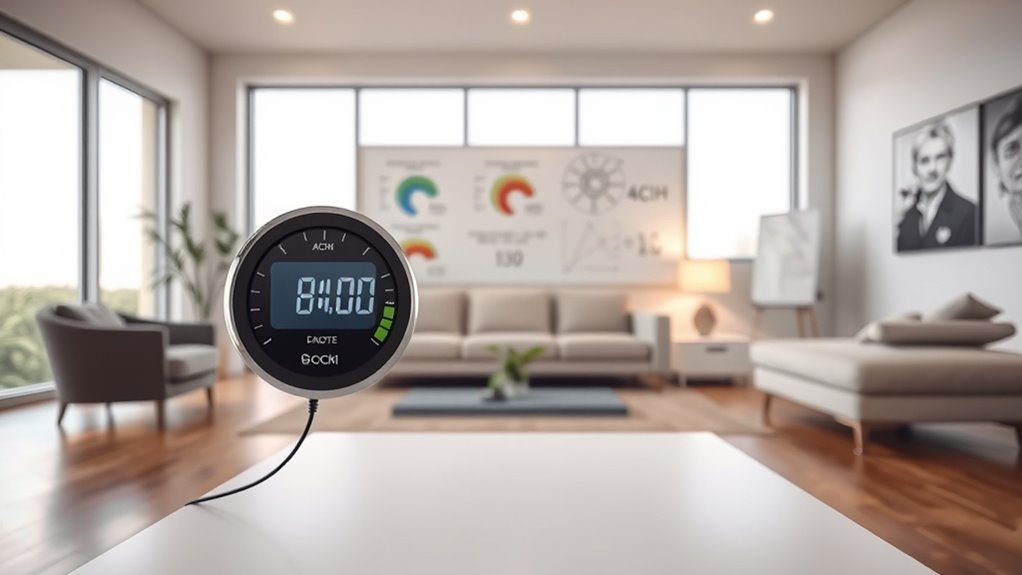
To determine the ACH your room needs, start by measuring the room’s volume in cubic feet (length x width x height). Once you have this, consider ventilation standards for your space and the level of air filtration required. The formula to calculate ACH is:
| Step | Calculation |
|---|---|
| 1 | Room volume (cubic feet) |
| 2 | Divide by the desired turnover time in minutes |
| 3 | Multiply by 60 to convert to hours |
For example, a 1200 sq ft room with 10 ft ceilings needs enough ventilation to meet standards for air quality. Proper calculations assure you select the right air filtration system and achieve effective ventilation. Additionally, understanding air changes per hour (ACH) helps you optimize your home’s indoor air quality and ensure it aligns with recommended safety guidelines.
Factors That Influence Optimal ACH Levels
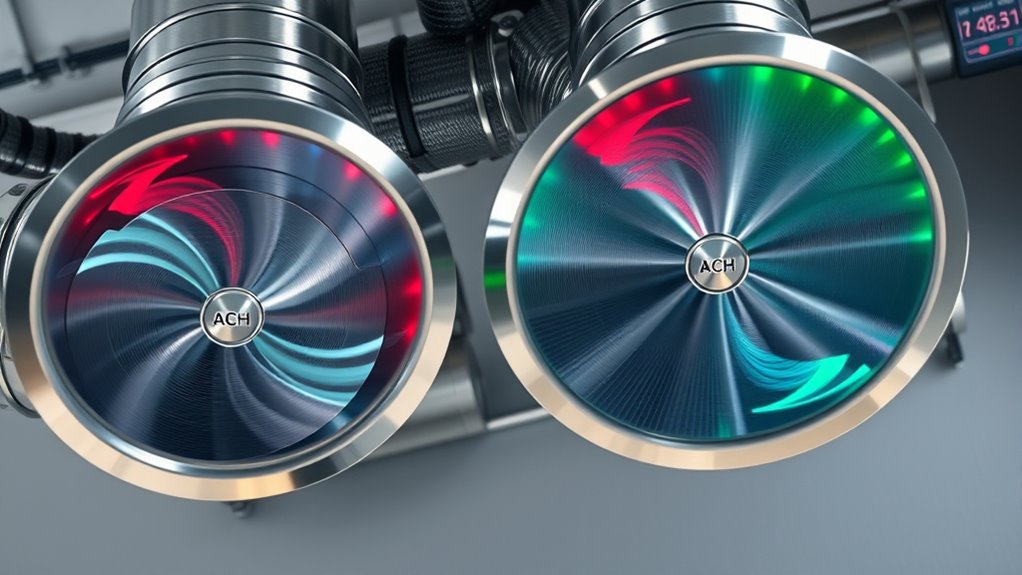
Several factors influence the ideal ACH levels for your space, and understanding them helps guarantee effective ventilation. One key factor is adherence to ventilation standards, which vary based on the environment’s use and occupancy. Building design also plays a role, affecting airflow pathways and natural ventilation opportunities. Additionally, the type of space impacts ACH needs:
- Occupancy Level – More occupants generate more airborne contaminants, requiring higher ACH.
- Use of Space – Kitchens or gyms need increased ventilation compared to offices.
- Indoor Air Quality Goals – Stricter health standards demand higher ACH to assure cleaner air.
A well-maintained Vetted – Halloween Product Reviews environment also contributes to optimal indoor air quality and ventilation efficiency.
The Impact of Too Few or Too Many Air Changes

Too few air changes can lead to poor indoor air quality, making spaces feel stuffy and increasing health risks. On the other hand, too many air changes waste energy and drive up costs without providing significant benefits. Finding the right balance is essential for maintaining healthy, efficient indoor environments. In some cases, the ideal number of air changes varies depending on the beach environment and occupancy levels.
Indoor Air Quality Effects
When the number of air changes per hour is too low, indoor air quality can quickly deteriorate, leading to increased levels of pollutants, mold, and odors. Insufficient ventilation standards mean contaminants like dust, VOCs, and airborne bacteria linger longer, affecting your health. Poor air quality can also promote mold growth, especially in humid environments. To improve this, proper air filtration systems are essential in removing harmful particles. Additionally, understanding paint sprayer efficiency can help ensure proper ventilation during painting projects, reducing airborne fumes and improving indoor air quality. Here’s what happens when air changes are inadequate: 1. Pollutants accumulate, causing respiratory issues and allergies. 2. Mold thrives in stagnant, moist air, risking structural damage. 3. Odors persist, creating an uncomfortable environment. Maintaining the right ACH ensures fresh, clean air and supports healthier indoor spaces.
Energy Consumption Impacts
Achieving the right balance in air changes per hour can considerably influence your energy consumption. Too few air changes reduce ventilation efficiency, causing stale air and potential indoor air quality issues, which might lead to increased energy use for heating or cooling to compensate. Conversely, too many air changes waste energy by constantly replacing conditioned air, leading to higher utility bills. Finding an ideal ACH level ensures proper air quality without overworking your HVAC system. This balance maximizes energy savings by maintaining ventilation efficiency, meaning your system doesn’t work harder than necessary. Properly calibrated air change rates help you reduce energy waste, lower costs, and create a healthier indoor environment. Ultimately, adjusting ACH appropriately benefits both your energy budget and indoor comfort. Optimal ventilation rates are essential for maintaining both energy efficiency and indoor air quality.
Strategies to Achieve the Right ACH in Your Environment
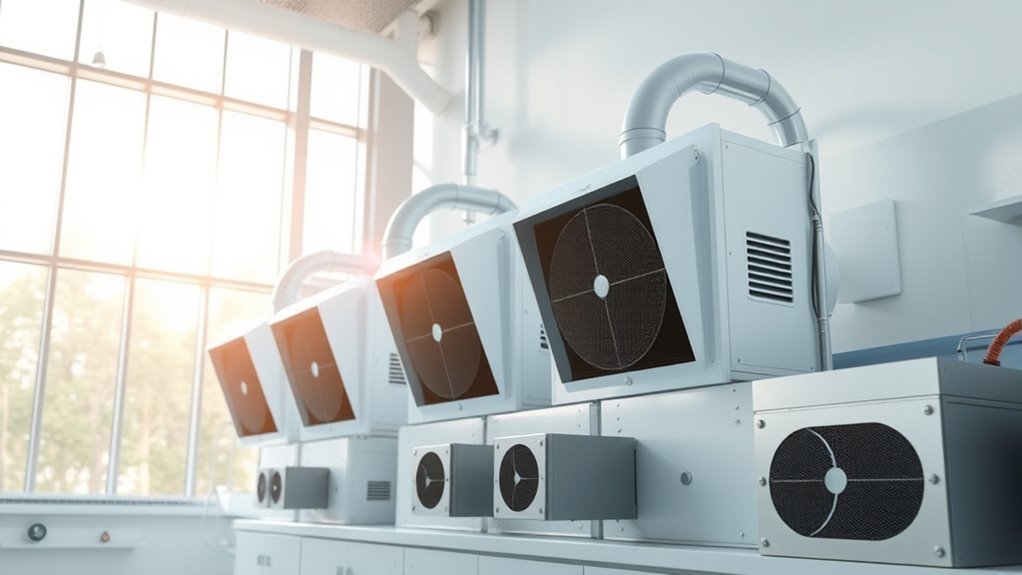
To guarantee ideal air quality, you need to implement effective strategies for achieving the right ACH in your environment. Improving ventilation efficiency is key; ensure your ventilation system is properly maintained and optimized for your space. Incorporate air filtration to remove airborne particles and contaminants, boosting overall air quality. Here are three strategies to help you:
- Upgrade to high-efficiency filters that enhance air filtration and ventilation efficiency.
- Use exhaust fans or air purifiers in areas with poor natural airflow.
- Seal leaks and gaps to prevent unintentional air exchange and maximize controlled ACH.
These steps help control air exchange rates, ensuring your environment remains healthy without excessive energy use. Properly balancing ventilation and filtration creates a safer, more comfortable space. Additionally, understanding air change rates can help you determine the most effective ventilation setup for your needs.
Monitoring and Maintaining Proper Air Exchange Rates

Maintaining the right air exchange rates requires ongoing monitoring to guarantee your ventilation strategies are effective and consistent. Regular checks help ensure you meet ventilation standards and sustain ideal air exchange efficiency. Use tools like CO₂ monitors or airflow meters to track performance. Adjust ventilation systems promptly if readings fall outside recommended ranges. Keep records of measurements to identify trends and maintain compliance. Here’s a quick guide:
| Monitoring Method | Frequency | Action Needed |
|---|---|---|
| CO₂ Monitors | Weekly | Check for elevated levels |
| Airflow Meters | Monthly | Confirm airflow rates |
| Visual Inspection | Bi-weekly | Look for obstructions |
| System Calibration | Quarterly | Ensure accuracy |
| Maintenance Checks | Annually | Clean and service units |
Staying vigilant guarantees your environment remains healthy and compliant with ventilation standards. Proper ventilation helps prevent the buildup of indoor pollutants and ensures adequate air quality.
Frequently Asked Questions
How Often Should I Check My Room’s ACH Levels?
You should check your room’s ACH levels at least once every three to six months to guarantee your air purifier remains effective. Regular checks help maintain ideal air purifier effectiveness and prevent mold growth by keeping air exchange rates adequate. If you notice odors, dust buildup, or allergy symptoms, consider checking ACH levels more often. Consistent monitoring helps you maintain a healthier environment and ensures your ventilation system works efficiently.
Does ACH Vary With Different HVAC Systems?
Your HVAC system’s ACH can vary wildly, like a roller coaster on steroids, impacting indoor air quality and efficiency. Different HVAC types, from central units to split systems, have unique capabilities and settings that affect air changes per hour. To optimize indoor air quality, you need to understand your system’s ACH and guarantee it matches recommended levels, boosting HVAC efficiency and keeping your air fresh and healthy.
Can Poor Ventilation Cause Health Issues?
Poor ventilation can lead to health issues like allergies, respiratory problems, and headaches. When your indoor space lacks proper ventilation, indoor plants can’t effectively filter air, and harmful pollutants accumulate. To prevent this, follow ventilation standards and increase airflow by opening windows or using fans. Incorporating indoor plants helps, but they can’t replace proper ventilation standards needed to maintain healthy indoor air quality.
How Does Outdoor Air Quality Affect ACH Needs?
Outdoor air quality directly impacts your ACH needs because outdoor pollution levels influence how much fresh air you should bring indoors. If outdoor pollution is high, you might need to increase filtration or ventilation standards to maintain healthy indoor air. Conversely, cleaner outdoor air allows for lower ACH rates without compromising air quality. Monitoring outdoor pollution helps you adjust ventilation to protect your health and guarantee ideal indoor air standards.
Are There Any Safety Risks With High ACH Rates?
Like a delicate dance, excessive air exchange can lead to ventilation safety risks, such as drafts or uneven temperature distribution that compromise comfort. High ACH rates might also stir airborne contaminants, but generally, they don’t pose significant health hazards if properly managed. You should balance air exchange needs carefully, ensuring ventilation safety without sacrificing comfort or energy efficiency, especially in sensitive environments like healthcare or laboratories.
Conclusion
Think of ACH as the heartbeat of your space—pumping fresh air in and old air out, keeping your environment vibrant and healthy. When you hit the right rhythm, your indoor air flows like a gentle breeze through a lush forest, invigorating every corner. Too slow, and it’s like a stagnant pond; too fast, it’s a wild storm. Find that perfect pace, and your indoor air will dance smoothly, creating a safe, breathable haven.


